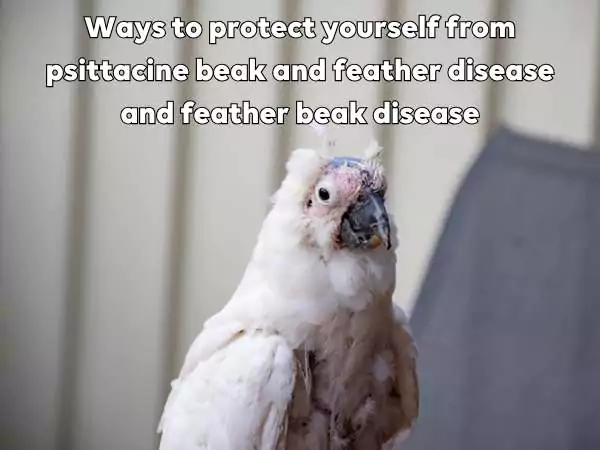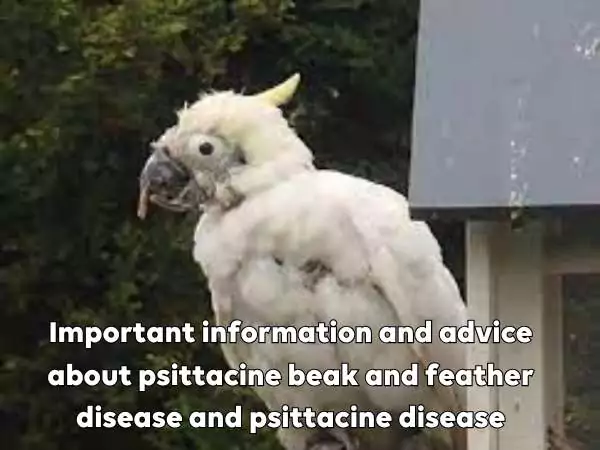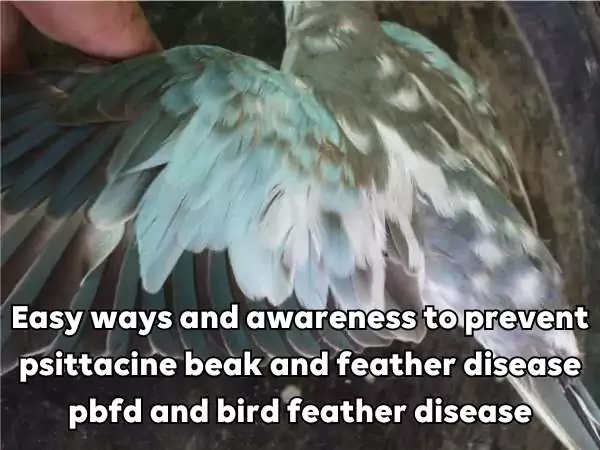Introduction
Psittacine beak and feather disease is a viral disease. This disease affects the beak and feathers of birds. It is mainly seen in parrots. The short name of the disease is PBFD. In this disease, the bird’s feathers fly off, the beak cracks, and the body gradually weakens. This virus is called ‘circovirus’. It is a very small and dangerous virus. This disease is also known by many other names like parrot feather disease, bird feather disease, and feather beak disease. The symptoms of this disease appear gradually. First, the color of the feathers changes. Later, the feathers fall out.
Problems such as curling of the beak, cracking, and failure to grow occur. Bird beak and feather disease or parrot beak and feather disease can cause similar symptoms. This virus spreads very quickly from one bird to another. This disease is mainly spread through the feathers, feces or saliva of infected birds. Cleanliness and awareness are very important in preventing psittacine disease. There is no specific cure yet to prevent pbfd bird disease. However, a clean environment and regular health check-ups can largely protect against this disease. In this article, we will know in detail about this disease.
Symptoms and remedies of parrot feather disease with psittacine beak and feather disease
Psittacine beak and feather disease is a serious viral disease. In this disease, the bird’s feathers fall out, the beak cracks and the body becomes weak. It is known as parrot feather disease. In parrot feather disease, the bird’s feathers are first damaged. Later, problems arise in the beak.
The beak may break, not grow, and even bleed. This disease usually attacks small parrots more. This disease spreads from one bird to another. The virus is spread through infected feathers, feces, and saliva. To prevent psittacine beak and feather disease, birds must be kept isolated. Cages must be kept clean.
Simple care rules to prevent parrot feather disease
A few things are very important to prevent parrot feather disease. First, the cage should be cleaned thoroughly every day. Second, the bird should be given good and nutritious food.
Third, before bringing a new bird home, you should seek medical advice. Because the psittacine beak and feather disease virus can remain in the body of any bird.
There is no specific medicine for this disease. However, care and awareness are the best ways to keep birds healthy. Regular monitoring is important to prevent parrot feather disease. If symptoms appear, treatment should be sought immediately.
Differences and similarities between psittacine beak and feather disease and bird beak and feather disease
Psittacine beak and feather disease and bird beak and feather disease although these two diseases seem similar, there are some differences. In both diseases, feathers fall out and problems with the beak occur. Psittacine beak and feather disease occurs only in psittacine species (such as parrots). While bird beak and feather disease can occur in all types of birds. It can also commonly attack other birds. The virus is active in both diseases. In both cases, the color of the feathers changes. The bird becomes weak and loses weight.
Similarities and differences with bird beak and feather disease
Bird beak and feather disease is very similar to psittacine beak and feather disease. However, some of its symptoms may be different. Sometimes, the beak is seen to be more twisted in bird beak and feather disease. Sometimes the feathers turn gray or ash-colored.
There is no specific treatment for these two diseases yet. However, cleanliness and keeping the birds separate are very important.
To avoid these two diseases, regular checkups must be done. Food, water, and cages must be kept clean. And if any symptoms are seen, you should seek the advice of an experienced veterinarian.
Awareness and care to prevent psittacine beak and feather disease and pbfd bird disease

Psittacine beak and feather disease and pbfd bird disease are the same viral disease. Its full form is “Psittacine Beak and Feather Disease” or PBFD for short. This disease causes major problems in the beak and feathers of birds. This disease reduces the immunity of birds. As a result, other diseases also attack easily. With pbfd bird disease, birds become weak, lose weight and can slowly die. Awareness is very important in preventing psittacine beak and feather disease. This virus can spread at any time.
Care to be taken to prevent pbfd bird disease
First, you need to know whether the bird is healthy. If any symptoms are seen, then you should take it to the doctor.
Secondly, the bird should be monitored regularly. If there are cracks in the beak, feathers falling out or weakness, you should be careful.
Thirdly, the cage should be cleaned every day. The bird’s food and water should be kept pure.
If there is care and love, psittacine beak and feather disease will not spread easily. Our attention and care are the biggest medicine to prevent this virus.
Ways to protect yourself from psittacine beak and feather disease and feather beak disease

Psittacine beak and feather disease is a viral disease. It is also known as feather beak disease. In this disease, the bird’s beak becomes weak. Feathers fall out. The body becomes weak. There are some easy ways to protect yourself from this disease. Clean the bird’s cage every day. Use hot water and mild disinfectant. Always keep the bird’s food and water clean.
Psittacine beak and feather disease can spread from one bird to another. So keep the new bird in a separate cage for a few days. This reduces the chance of spreading the virus. Take the bird to the veterinarian regularly. If you notice any changes in the body, take immediate action. Feather beak disease can cause the beak to become crooked or broken. At this time, the bird should be fed soft food.
Clean environment and isolation are the most effective ways
To protect yourself from psittacine beak and feather disease, you must first pay attention to the environment. The cage should always be kept dry. Germs spread quickly in wet cages.
Keeping birds in a clean place reduces the risk of spreading feather beak disease. Keeping many birds together spreads the virus more. Therefore, it is important to keep sick birds in separate cages. Do not keep birds affected by psittacine beak and feather disease with healthy birds. This spreads the virus further. Taking timely steps can prevent the spread of the disease.
Important information and advice about psittacine beak and feather disease and psittacine disease

Psittacine beak and feather disease and psittacine disease are basically caused by the same virus. In this disease, the bird’s body becomes weak. Feathers fall out and cracks appear on the beak. Psittacine disease attacks young birds more. They are infected quickly and their chances of survival are reduced. This virus cannot be cured, but it can be prevented.
If symptoms of psittacine beak and feather disease appear, isolate the bird. Feed it soft food and give it adequate rest. This disease reduces the bird’s immunity. As a result, they are easily infected with other viruses. So take measures before the disease starts.
Prompt treatment and awareness are needed when the disease starts
As soon as you see the symptoms of psittacine beak and feather disease, you should seek medical help. If you delay, the bird’s life is at risk. In psittacine disease, the body’s feathers grow strangely or fall out. The beak may become large and curved. At this time, the bird needs to be kept alone and fed well. If there are children in the family, keep them away from birds with this disease. Awareness is very important in preventing the disease.
Treatment and protection of psittacine beak and feather disease and parrot beak and feather disease
Psittacine beak and feather disease is not yet completely curable. However, some protective measures can be taken to prevent parrot beak and feather disease. To keep the bird free from disease, it should be kept in a clean place. The cold-hot environment cannot be changed. It should be fed with vitamin-rich food regularly.
In case of psittacine beak and feather disease, the veterinarian can help reduce the symptoms with some medications. For example, painkillers and creams are used for lip care. In case of parrot beak and feather disease, the lips may crack. At this time, it is difficult to eat. Therefore, soft and warm food should be given.
Recovery is possible with regular health check-ups and proper care
Regular health check-ups are very important in the treatment of psittacine beak and feather disease. To prevent parrot beak and feather disease, take the bird to the veterinarian at least twice a year. If you see any abnormalities, take action without delay. Good food, clean water and cleanliness are the main tools to prevent psittacine beak and feather disease.
Read More:
Easy ways and awareness to prevent psittacine beak and feather disease pbfd and bird feather disease

Psittacine beak and feather disease pbfd spreads very quickly. Bird feather disease also destroys the feathers of birds. Some simple ways to prevent this disease should be followed.
First of all, the bird should be loved and cared for. Its environment should be kept clean and dry. It is better not to keep it with old birds immediately after buying a new bird.
To prevent psittacine beak and feather disease pbfd, you should also be careful with food. Old or stale food should not be fed to the bird. Clean water should be given.
The most important thing to prevent bird feather disease is to be aware. Every symptom should be noted. Feather loss, color change or crooked beak means it is time to be careful.
Daily care and love are the key to disease prevention
To prevent viruses like psittacine beak and feather disease pbfd, you should take care of the bird every day. Clean the cage every day to prevent bird feather disease. Keep an eye on the bird’s body. Get treatment as soon as you see changes. Psittacine beak and feather disease pbfd is a dangerous disease, but if you are aware, you can keep your beloved bird healthy.
Conclusion
Psittacine beak and feather disease is a disease that is very harmful to the health of parrots. The feathers, beak, and body strength of the bird decrease. Feather beak disease, bird feather disease, and parrot feather disease all carry symptoms of this virus. To avoid this disease, every bird keeper should be careful. Clean cages, healthy food, and regular treatment are essential. The easiest way to avoid parrot beak and feather disease or bird beak and feather disease is to be aware and understand the early symptoms.
Pbfd bird disease is not yet curable. However, it is preventable. By maintaining cleanliness and keeping sick birds isolated, it is possible to prevent the spread of the virus to a large extent. Psittacine disease usually attacks young birds more. Therefore, it should be thoroughly examined before bringing new birds into the house. The most important thing is to love and care for every pet bird. Being aware of bird feather disease prevention means keeping your bird healthy for a long time. Psittacine beak and feather disease spreads very easily, but prevention is possible. Our awareness is the key to protecting ourselves from this disease.
FAQ
Is psittacine beak and feather disease really serious?
Yes, psittacine beak and feather disease is a very serious viral disease. It weakens the bird’s beak, feathers, and immune system. As a result, the bird slowly moves towards death.
How is psittacine beak and feather disease spread?
This disease is spread from the feathers, droppings, saliva, or house of an infected bird. If one bird is infected, others can also be infected.
Is psittacine beak and feather disease curable?
Unfortunately, there is no permanent cure for this disease. However, with some medication and care, the life span of the bird can be increased somewhat.
What can be done to prevent psittacine beak and feather disease?
It is very important to maintain a clean environment, test new birds before bringing them in, and isolate sick birds.
Why do birds lose feathers in psittacine beak and feather disease?
In this disease, the roots of the bird’s feathers become weak and the feathers start falling out due to the virus infection in the body.
How can psittacine beak and feather disease be diagnosed?
It can be easily diagnosed through lab tests, feather condition, beak breakage, and weakness.
How can other birds be saved from psittacine beak and feather disease?
Isolate the affected bird, clean the bird’s nest, and keep all birds under observation.
What damage does psittacine beak and feather disease do to the bird’s beak?
The beak cracks, becomes deformed, and gradually becomes unable to eat.
Can birds survive psittacine beak and feather disease?
In some cases it survives, but in many cases it causes death.
Is psittacine beak and feather disease dangerous for pet birds?
Of course. This disease is very dangerous for pet birds and spreads quickly. Awareness and regular check-ups are the only way.

